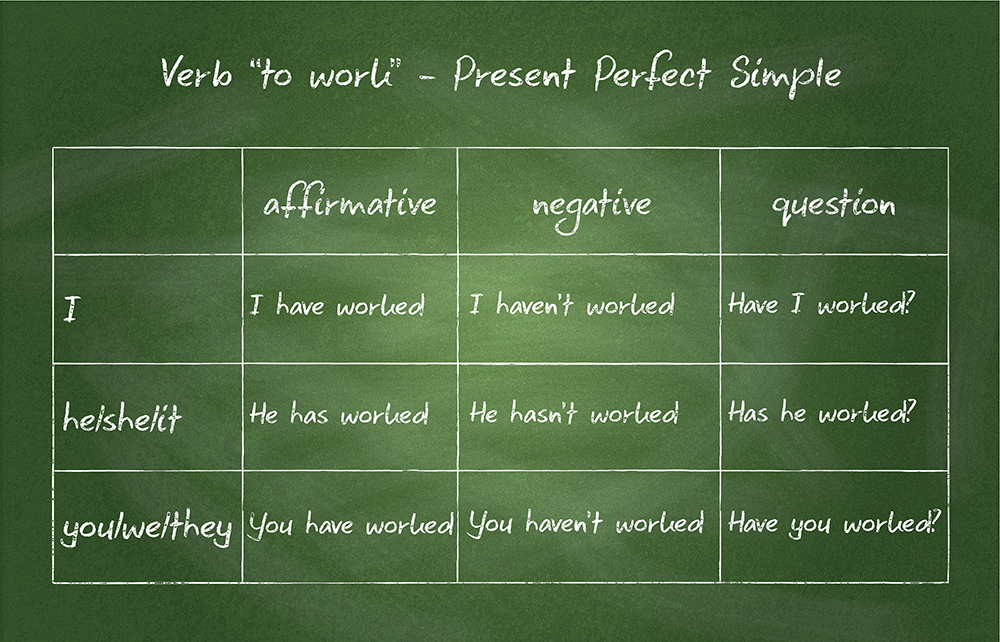
The Present Perfect Tense
The present perfect tense tends to make English learners anxious, but let’s take a good look at it and calm your fears! It’s very easy to make, though learning when to use it may take a little practice. This lesson is an introduction to the basics of the present perfect tense.
Take a look at these examples:
But everyone who has done right will shine like the sun in their Father’s kingdom. (Matthew 13:43)
Many people have tried to tell the story of what God has done among us. (Luke 1:1)
Then in a loud voice she said to Mary: God has blessed you more than any other woman!…” (Luke 4:21)
“Has done,” “have tried,” and “has blessed” are all used in the present perfect tense. This tense is used to describe something that started in the past, but continues into the present. It doesn’t describe a simple event that began and ended in the past.
People who “have done” right started to do right in the past, and continue to do right.
Many people “have tried” in the past to tell the story, and they continue to try.
God blessed Mary in the past, when she conceived, and continued to bless her into the present, that is, when these words were spoken by Elizabeth.
The Present Perfect Is a Compound Verb
you have worked
he/she/it has worked
we have worked
they have worked
Using the Present Perfect to Talk About the Past
Past Events That Are Important in the Present
Another very common way to use the present perfect tense is to talk about an event that began and ended in the past, but it is still important in the present. Here are some examples:
I have lost my keys, and I can’t get into the house.
Even though there was one event in the past where the keys were lost, the effect of that action continues into the present – he can’t get into his house. Here’s another example:
Can I have a snack now? I have finished my homework.
Even though the homework was started and ended in the past, the present action of having a snack depends on that action. In this case, you can use the present perfect. You could also use the simple past in these sentences. The meaning is the same.
I lost my keys, and I can’t get into the house.
Can I have a snack now? I finished my homework.
The "-ed" Past Participle
As we have already talked about, to make the present perfect we need the verb “have/has” plus a past participle of the action verb we want to use.
Regular Past Participles
A regular past participle is made by adding -ed to the end of a verb.
work – worked
finish – finished
notice – noticed (if the verb ends in “e,” we don’t need to add another “e.”
These verbs look the same as the simple past tense – confusing, right? Just remember that the helping verbs “have” or “had” will always come before them in the present perfect tense.
Irregular Past Participles
We’ve already talked about the fact that many common verbs have irregular past participles. You will just have to learn them – but since they are common, with practice they should be easy to remember! Here are a few of the most common irregular past participles:
eat – eaten
go – gone
come – come (the word is the same)
see – seen
write – written
know – known
give – given
You can do more research online to find more verbs that have irregular past participles. I have also attached a reference sheet for you that lists more of the most common irregular past participles. We will also talk more about past participles in a future lesson (coming soon).
Asking Questions With Present Perfect
You’ve already seen an example of a question in the present perfect – when Jesus asks Simon, “Have you noticed this woman?” To make a question, just move the helping verb “have” or “has” to the beginning of the sentence. Here are some more examples:
You have noticed this woman.
Have you noticed this woman?
She has washed my feet with her tears.
Has she washed my feet with her tears?
My Father has given me everything… (Luke 10:22)
Has my Father given me everything…?
Making Negative Sentences With the Present Perfect
To make your present perfect sentence negative, just add the word “not” after the helping verb.
You have noticed this woman.
You have not noticed this woman.
She has washed my feet with her tears.
She has not washed my feet with her tears.
My Father has given me everything.
My Father has not given me everything.
As in all compound verbs, when you want to make a compound verb negative, you will put the word “not” after the helping verb.
Contractions
To speak more quickly and preserve the rhythm of English speech, English speakers will also make contractions out of these verbs. You can, too. But you don’t have to. You will be understood easily if you choose to pronounce each word completely.
He‘s talked with you. (he has)
I‘ve finished work for the day. (I have)
We‘ve eaten this dish before. (we have, in the past, and we plan to eat it again soon)
Make a contraction in a negative sentence by combining the helping verb with the negative word “not.” Remember, the present perfect ties the past to the present in some way, even in a negative sentence.
He hasn’t talked with you. (he has not talked with you yet, but he will soon)
I haven’t finished work for the day. (I haven’t finished yet, but I will finish soon)
We haven’t eaten this dish before. (We have never tried this dish before, but we will try it now)
Negative Sentences That Express Disbelief
One common way native speakers use negative statements with the present perfect is to express disbelief, or disapproval. Look at these examples:
Haven’t you finished your homework yet?
(What is taking you so long?)
Hasn’t she visited England before?
(I can’t believe she has never visited England!)
Haven’t we seen this movie before?
(I thought we saw it last year, but I could be wrong.)
The Verb "To Be" in the Present Perfect
You can use the verb “to be” as a participle in the present perfect tense. It is irregular, and is spelled “been.”
I have been to Greece.
He has been tired a lot lately.
They have been with the doctor for a long time.
You can see that in these sentences, the present perfect verb is followed by a preposition (to, with). It can also be followed by an adjective that describes the subject. These sentences are in the present perfect, using the helping verbs “have” and “has” with the past participle “been.”
However, many times the verb “have/has been” will be followed by a verb in the “-ing” form. Look at these examples:
I haven’t been eating much lately.
He has been driving to work every day.
We have been trying not to complain about it.
In these sentences, we are not using the present perfect tense of the verb. We are using the present perfect CONTINUOUS form, which is a different tense.
So don’t be confused! Stay tuned for our next lesson, where we will look at the present perfect continuous tense in more detail!
Using Adverbs With Present Perfect
You can add emphasis to what you are saying by using an adverb of time between the helping verb and the main verb. Some adverbs of time you could use include ever, never, always, usually, recently, and just. Here are some examples:
I‘ve never eaten sushi. (or: I haven’t ever eaten sushi.)
He has always been on time.
Hasn’t she ever been to England before?
We‘ve just returned from our trip.
He‘s recently become engaged.
She‘s usually been faithful to text me every day.
Present Perfect Worksheet
The Next Present Tense - Present Perfect Continuous
We use the present perfect to talk about the result of the action, or how the present is affected by the action that started in the past. When we use the present perfect continuous, we emphasize the action itself, not the result. In the next lesson, we’ll talk more about how these tenses are different, and give you lots of examples! Click here to go to that lesson now. (coming soon)
